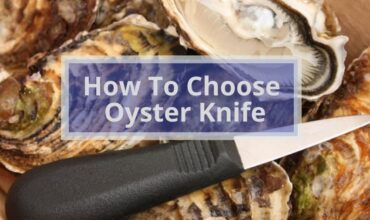What is more delicious than eating fish? almost nothing. but at the same time, there is nothing worse than having a messy countertop full of fish scales, right?
That’s why in this handy step-by-step guide we will be showing you how to scale fish like a pro!

What Are the Steps in Scaling Fish?
Required Tools
- Parchment paper or a newspaper
- Running water
- Disposable gloves
- A knife
Steps
1- Rinse The Slime Off The Fish
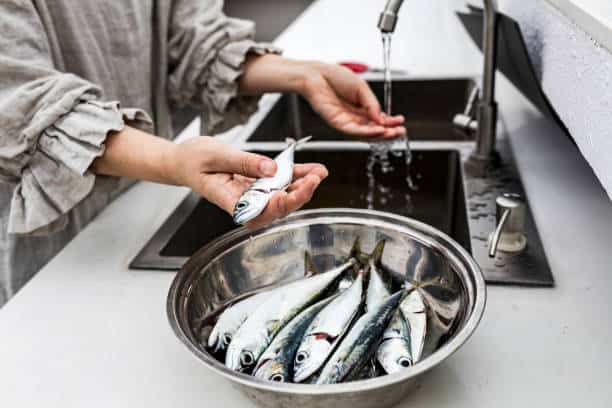
To be able to scale fish first thing you need to do is to hold the fish firmly, you need to take the slim off or grip the fish using a dry rag or towel. and after you remove the slim, keep rinsing the fish to loosen its scales on both sides.
2-Place The Fish on a Protective Covering
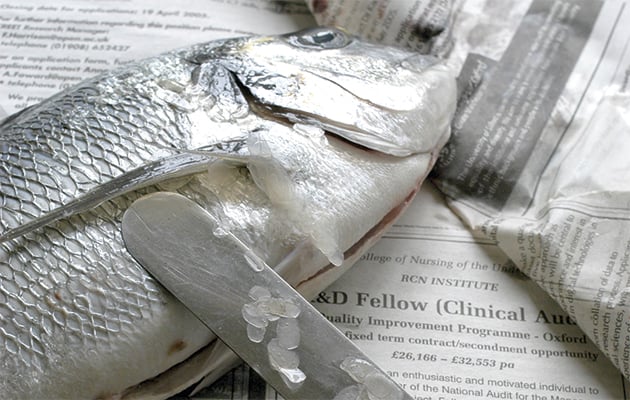
It is recommended to use a protective layer to keep your cutting board or countertop clean while scaling.
3-Grip The Fish Tightly From The Tail
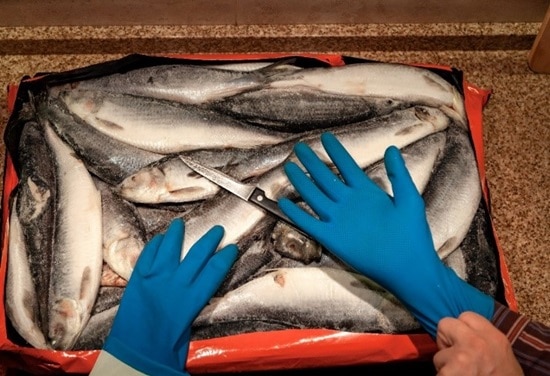
After laying the fish on the newspaper, grasp its tail firmly with your non-dominant hand to prevent slipping. it is worth mentioning that fines and scales can be sharp so it is always recommended to wear rubber gloves.
4-Hold The Knife and Spin It to its Dull Side
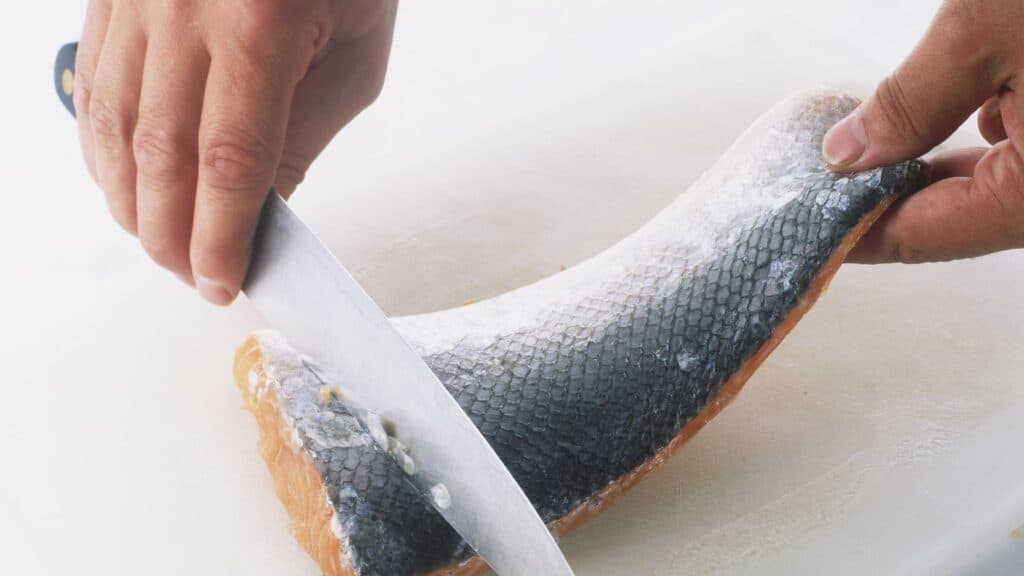
The sharp edge of your chef knife or even butter knife can cut the fish instead of scaling it. So scaling should be done with the blunt edge of the knife.
On the other hand, for fish species with tough skin, you can use a sharp knife edge. But keep in mind that your blade will scrape over the scale’s top and not within the fish’s delicate flesh.
All you need to do is to grip the blunt edge at a 45-degree angle and place it right up against the skin of the fish close to the tail fins.
5-Scraping the Fish

Rake the backside of the knife over the fish. You should scale fish from the tail to the head. while performing even long strokes. Applying a little pressure while scraping will make the loose scales pop off.
Keep scaling till you remove all the scales from this fish side and then turn it over, and repeat.
6-Rinse the Scales Residue
After taking removing the scales, grip the fish under running cold water to completely remove the leftover fish scales.
Other Techniques for Scaling Fish
1-Take Off the Skin Before Cooking

Required Tools
- Cutting board
- A sharp knife
Steps
- Flat the fish on the cutting board.
- With your sharp knife, take off all the fish skin involving the scales. Cut near to the skin to avoid wasting any fish.
2-Use a Fish Scaler
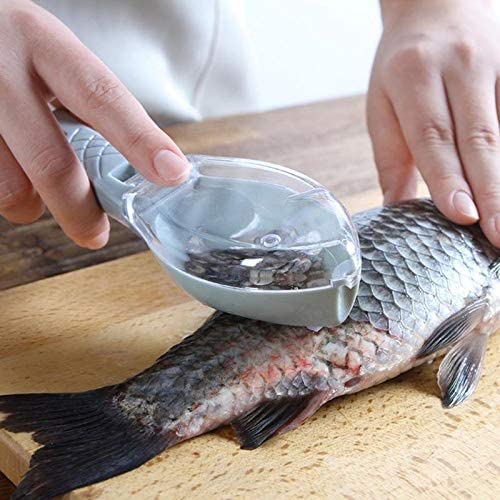
A fish scaler is a special tool designed especially to scale fish. it looks like an extreme hairbrush that has a non-slip handle and jagged metal edges. Scaling the fish’s outer layer with a fish scaler is super easy and fun.
Required Tools
- Fish scaler
- Running water
- A protective layer ( parchment paper)
Steps
- Grip your fish firmly by the tail.
- Next, with the fish scaler, Continue scraping the entire fish.
- After that, rinse the fish with water.
It would help if you worked against the scale’s direction. Using long, even strokes will make the scales peel easily.
Now you knew the right ways to get a perfectly clean, scaled fish, it is time to move to the second step: gutting!
Cleaning and Gutting Fish
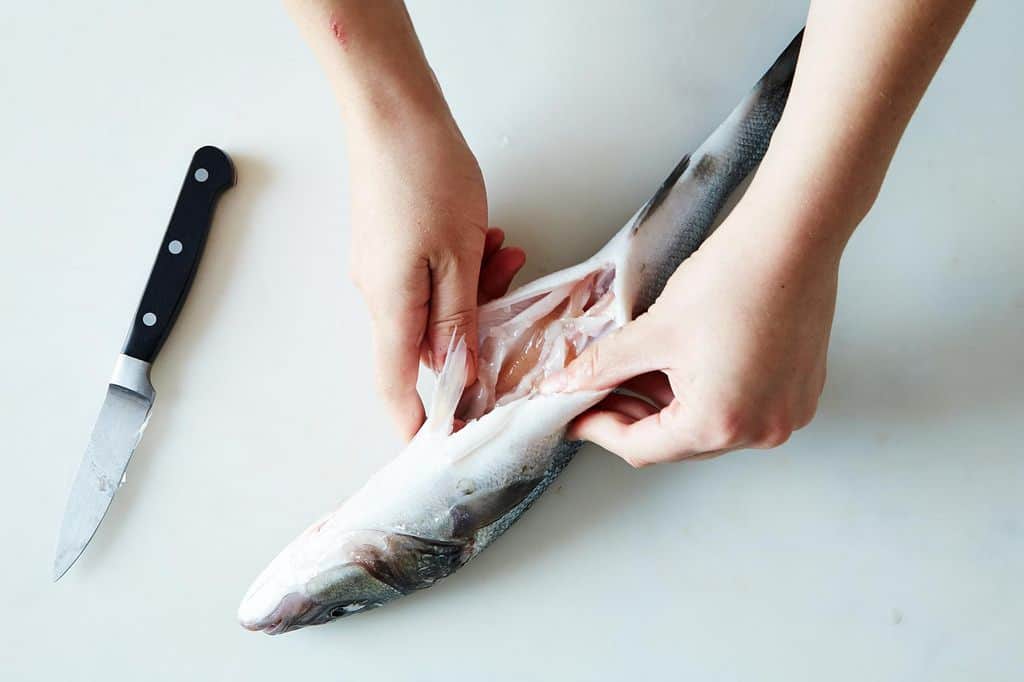
Required Tools
- Rubber gloves (optional)
- Fish knife
- Cutting board
- Spoon
- Cold running water
- Trash bin
Steps
1- Slide the Knife Tip Within the Vent of the Fish
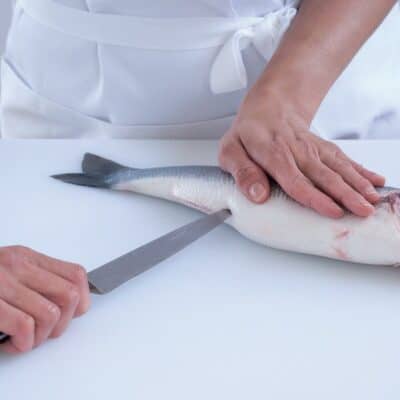
Line the fresh fish flat with the belly facing you over a stable cutting surface while leaning it 45-degree angle in a way that its head is facing far from you.
Make the fish knife edge face the fish’s head. then insert its end into the fish anus.
Depending on the size of the fish, insert the knife end between 1-2 inches (2.5-5.1 cm) into the vent.
The vent is the lower part of the underside of the fish. In contrast, the anus is the tiny opening close to the tail’s bottom part. It always has various colors from the remaining vent of the delicious fish.
2-Cut Towards the Neck
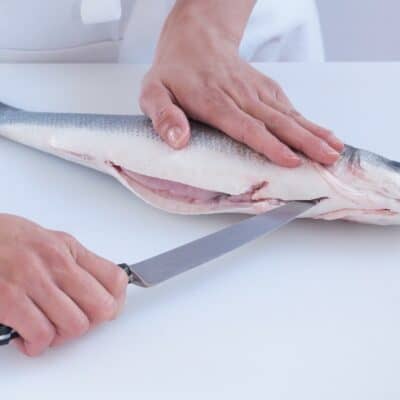
Hold your knife firmly and continue moving it up and down at a distance of 0.5 inches (1.3 cm) as you slide it along the fish opening.
Keep cutting until you reach 1–2 inches (2.5–5.1 cm) under the fish’s mouth. make sure you don’t go deep within the belly of the fish while cutting it, because If the intestines rupture, the fish inside will be messy.
It is worth mentioning that in this step you can also use kitchen shears instead of a knife.
3-Open the Stomach and Take off the Guts and Intestines
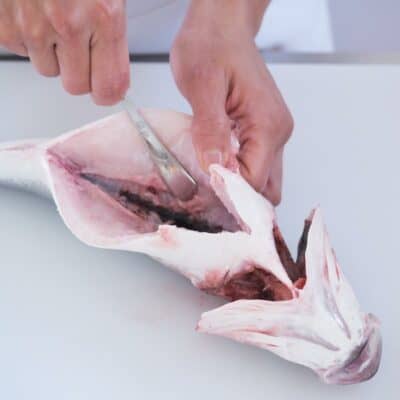
Start spreading both fish sides at the vent with a 2-6 inch, without ripping the cut (5.1–15.2 cm). then gently press the organs where they are connected to the broad head.
Now, take off the guts and intestines and the body cavity to see if there is any organ residue. If there are, take them off with your hand and throw them.
4-Extract the Kidney of the Fish Spine (If Found)
Some larger fish species have a tiny kidney inside the spine close to their middle. So, search for the kidney, which is a small organ in a bean shape. If found, extract it with a spoon.
5-Rinse the Fish Under Running Water and Clean the Stomach Cavity
Some larger fish species have a tiny kidney inside the spine close to their middle. So, search for the kidney, which is a small organ in a bean shape. If found, extract it with a spoon.
Open the fish’s stomach body cavity and start rinsing it in your sink under the running cold water. at the same time scrub, it with a spoon or your hand to take off any organ residue and make the flesh clean.
Keep cleaning the fish for at least one minute, to ensure reaching each portion of the fish’s stomach cavity.
How Long Can you Keep Fish Before Gutting?
Ungutted lean fish can be kept in the fridge for up to 72 hours, while fatty fish can be kept for up to 48 hours. However, storing an ungutted fish in the refrigerator for more than 24 hours is not recommended.
Do I Need to Scale a Fish before Cooking it?
If you want to get the most flavor out of your freshly caught fish, remove the scales before the fish preparation process. Even if you intend to burn the scales off, the flavor may be affected.
Can You Scale a Frozen Fish?
Yes, you can
to scale fish that has been in the freezer for a while, you will need to hold the fish under cold water as you move a fillet knife against the grain of the scales to break them off. Removing the scales and yet leaving the skin on the fish will help it keep together and make the process of fish preparation more evenly.
FAQ about How To Scale Fish
1-How Can You Clean and Care for Fish Scalers?
Fish scalers can be similar to other fishing gear pieces. Cleaning and storing them correctly is necessary if you want them to last for a long time.
If you use a metal brass fish scaler, you should usually use fresh water for rinsing it. This step will remove any debris and dirt. After that, coat it with a layer of protective oil/spray. to avoid rust and corrosion during storage.
If you use a fish scale scraper with a wooden handle, do not immerse the wooden portion in water. You have to keep it dry.
2-Is It OK to Eat Fish Scales?
Yes, you can eat them. But it will not be a tasty one. Actually, in some dishes, the fish scales can be cooked. But, it is advisable to do this with large fish with stubborn scales.
3-Do I Have To Take Off the Salmon Scales?
A lot of individuals eat salmon fillet skin, especially if it is crispy. However, you should remove the scales when you buy the fish. You should know how to scale fish with a butter knife or fish scaler tool.
Final Thoughts
You should consider that the odor of the fresh fish can be terrible. Therefore it is better to use a perfumed dishwashing liquid to wash all the equipment you used during each process.
And now we expect you to perfectly know how to scale fish like a pro!
